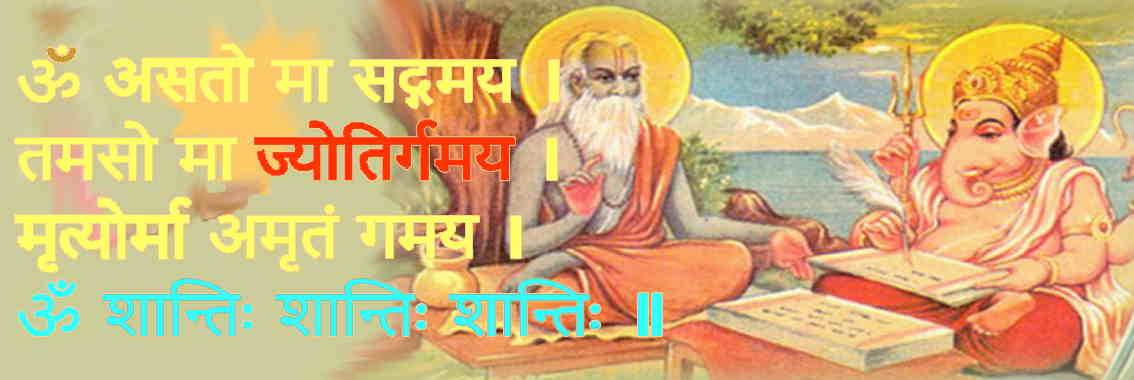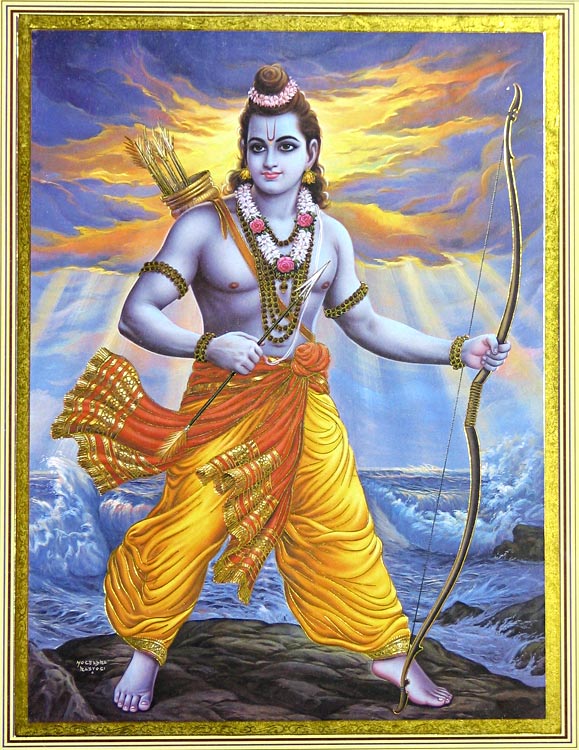Extolling Śrī Rāma
Rāma Navami is the celebration of the birthday of the ascetic king Rāma from the sacred epic Rāmayana. Śrī Rāma is the embodiment of perfect character who follows his duty. He is known as the Puruṣottama, the best amongst men and extolled with the mantra
ॐ नमो भगवते उत्तमश्लोकाय
om namo bhagavate uttama ślokāya
Śrī Rāma is the 7th avatar of Viṣṇu who walked on earth to uplift mortals. Worshipping Śrī Rāma is akin to the worship of the exalted Sun that makes our thinking upright. Uprightness is ārjavam (आर्जवम्) in Sanskrit and it represents the integration of body, mind and spirit in thoughts, words and action. It is one of qualities enumerated in the Bhagavad Gītā as belonging to a sattvic natured person. Though the rays of the sun light fall straight, they may slant in the evening as the shadows get stronger but they are never crooked. Many consider the energy of the Sun hard to bear, find it unrelenting in going about in the performance of its duties – it rises every single day even in the heat of the summer.
Sun light is responsible for all life. It takes away the darkness and reveals all. Sometimes the darkness is just ignorance or delusion which envelopes us our body and mind like a cloud. This darkness is in the form of one of the sextuplets – i.e. ṣad ripu (six forms of challenges) which gives us the motivation to sustain our mundane life or saṁsārā. They are desire (kāma), anger (krodha), greed (lobha), delusion (moha), intoxication and arrogance (mada) and jealousy (mātsarya). They are lurking deep inside our minds inherent to our personality, thereby limiting us in achieving our true potential by colouring the perception and understanding of the world around us. The 6th house in a horoscope can show challenges of an individual both external and internal. More to be elaborated in a separate article on behaviour, shad ripu and the planets associated with each one of them in Vedic astrology.
The famous psychologist Carl Jung named these unrecognised inner aspects as complexes. He once said, “We all have complexes. That is not the question. The only question is whether we have complexes or they have us.” These complexes demand to be expressed and will surface. The same concept was explained by Śrī Kṛṣṇa in the Bhagavad Gītā emphasising that these tendencies are indeed very deep rooted and become ingrained in us from many past lives. “Propelled by our vāsanās (particular imbedded nature), we are inclined to act in accordance with our individual modes. Even those who are learned carry with them the baggage of the saṁskārās (tendencies and impressions) of endless past lives, the prārabdha karma of this life, and the individual traits of their minds and intellect. They find it difficult to resist this force of habit as expressed in the phrase in “गुणा गुणेषु वर्तन्त (guṇā guṇeṣhu vartanta)”. This is because the various sense organs of seeing, touching, hearing etc are constantly expressing themselves in the world of objects unrestrained, thereby generating new emotions, thoughts desires and actions.
Most of our actions in life stem from one of these internal sextuplets which are embedded in our nature and propels us to act and react to circumstances which lead to more karma and consequences to mete out in this life or in many future lives. A true yogi or seeker is one who introspects, reflects and destroys his inner demons, i.e. ṣad ripu that engulfs his true inner nature. However, a few of us have the courage to confront them consciously. Before reacting every time, it may be worthwhile to consider which amongst the six is motivating our thought process. A well placed and strong Sun in a horoscope can help as the fire element is responsible for correct vision and digestion of knowledge.
How can the epic Rāmayana help us?
The entire journey of a spiritual seeker can be compared with the story in Rāmayana where Śrī Rāma gets separated from his consort Sītā as she is captured by the ten-headed demonic person Rāvaṇa. Symbolically the couple are inseparable and yet in most part of story they were separated. Śrī Rāma’s anxiety for Sītā was palpable until he crossed the great ocean with the help of monkeys to defeat Rāvaṇa and get her back. Similarly, we too have lost our peace in life as our inner demons have taken hold of us and make us run after the worldly possessions to make ourselves happy. We are constantly looking for external validation. We too have to fight them to get back what is truly hidden inside and is inseparable from us the bliss. This can only be achieved by crossing the vast ocean of delusion caused by ignorance. This ignorance is failing to accept the true permanent blissful nature of beings by making happiness conditional.
The same idea is enumerated in the following verse in the reflective advaitā text ātma bodhā by ādī śaṇkarācāryā
तीर्त्वा मोहार्णवं हत्वा रागद्वेषादिराक्षसान्।
योगी शान्तिसमायुक्त आत्मरामो विराजते॥
tīrtvā mohārṇavaṁ hatvā rāgadveṣādirākṣasān|
yogī śāntisamāyukta ātmarāmo virājate ||
After crossing the ocean of delusion and killing the monsters of likes and dislikes, the yogi who is united with peace dwells in the glory of his own realised Self as an ātmārāma (totally revelling in oneself)
This verse helps us in understanding the true meaning of the word Rāma which is derived from the root raṁ (रं) meaning one who revels in himself (रमन्ते अस्मिन् इति रामः) without the help of world of external objects. Rāma is the truth that is inside all of us. Rāma is true peace. Rama is bliss.
To conclude it is said that chanting or meditating the name of Rāma is so blissful and it is like reciting the entire Viṣṇu sahasranāma (1000 names of Viṣṇu).
श्री राम राम रामेति रमे रामे मनोरमे
सहस्र नाम तत्तुल्यं राम नाम वरानने
śrī rāma rāma rāmeti rame rāme manorame
sahasra nāma tattulyaṁ rāma nāma varānane
By meditating on the name of Rāma, my mind gets absorbed in the divine consciousness of Rāma, which is transcendental, the name of Rāma is as good as the thousand names of Viṣṇu
श्री रामः शरणं मम
śrī rāmaḥ śaraṇaṁ mama



Fantastic article., especially linking various aspects from advaita to astrology and modern philosophy
Our local Bhagvad Gita sat sangh guide conducted a Ramayana parayanam using Kamala Subramaniam book. It was equally blissful